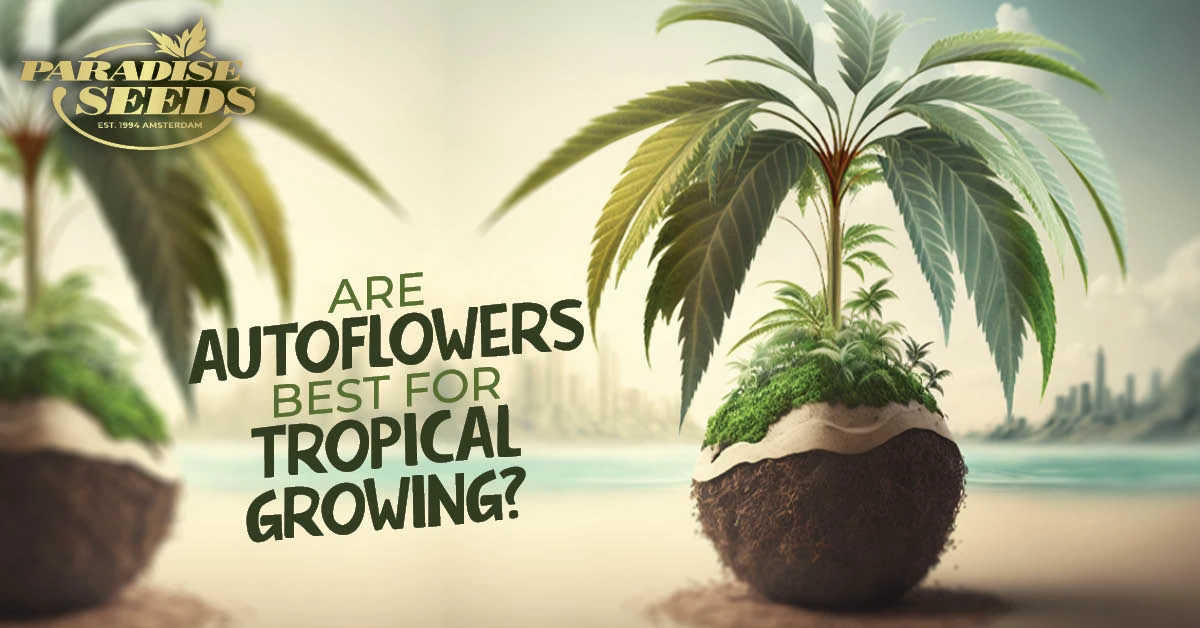Autos first hit the scene over a decade ago, and while they have made some great leaps over the years, there is still some stigma and misinformation surrounding them, so this grower’s story from Sam North asks are autoflowers best for tropical outdoor growing?
Sure, they started out as small growing, low potency options with limited yield potential – but thanks to the hard work and dedication of a handful of passionate breeders, autoflowering weed strains can now hold their own against the very best top-shelf photoperiod strains. And what’s more, they are up there with the best options for those among us living in tropical climates (although photoperiod plants can still work pretty well).
I’ll be honest, it was only pretty recently that I truly gave autos a shot. I’m an outdoor gardener, and for years I have grown the same photoperiod strains. For me, it’s important that I know the ins and outs of a particular strain, and love really getting to understand how each strain I choose to grow works. But after a recent move to a tropical climate, I thought it was high time to try something new.
Why are autoflowers best for tropical outdoor growing?
Before making any decision on which strains to try, I jumped online and did a quick search. As you likely well know, there’s a wide range of advice on what the best options are for growing outdoor weed in warm and humid tropical climates. It can all be a little overwhelming. After a bit of experimentation, in my opinion, the resounding winner for tropical growing is auto cannabis. There are a few key reasons for this line of thinking, so let’s dive headfirst into why I believe every tropical grower should switch over to autoflowering strains.
Autos are less light-sensitive so ideal for tropical areas
The first, and probably the most obvious reason when considering tropical growing is that autoflowering strains are less sensitive to light schedules than their photoperiod cousins. Photos need more light (eighteen hours on, twelve hours off) to stay in the vegetative stage of growth. Mother nature just can’t produce that light schedule close to the equator, with the longest days usually only having about 13 hours of light. You can get around this issue by using some artificial light to trick the crop into staying in veg, but why bother?
Autos have an inbuilt genetic timer that automatically switches the growth pattern to the flowering stage after a certain number of weeks – usually 3 or 4 – no matter the lighting conditions. This means that you can avoid any fiddly light manipulation, which can save you a lot of time and hassle (not to mention energy bills), and it just makes the process that little bit easier.
Autos have a higher resistance to both mold and pests infestations
Tropical areas are, by their very nature, hot and humid – the perfect breeding ground for mold spores and pests. And while you can take measures to prevent both of these issues from arising, it’s always nice to have a bit of an insurance policy in place.
Fortunately, autoflowering strains tend to be more resistant to both mold and pests than their photoperiod cousins. This is, of course, a bit of a generalization and is definitely strain dependant, but an auto such as Auto Wappa, from the Paradise Seeds collection, has a reputation for resistance and adaptability to a range of different climates and tropical growing conditions.
Autos are easier to grow in general
If you are wondering how to grow weed in tropical areas, or if you’re just looking for an easy crop, then autoflowering strains are the way to go. They are, quite simply, easier to grow than photoperiod strains.
New auto genetics now produce big yield plants
This one might surprise you, but autoflowering strains’ yield size can match (and even have the potential to out-yield) their photoperiod cousins. Some growers think that because they pack all of their growth into a shorter time frame, there is no way they can match photos. This is just not true anymore – just take a look at the monster harvest capabilities of a sativa leaning strain like Stromboli Auto (with recorded yields of 150g+). Most autos take anywhere from 9 to 11 weeks from seed to harvest.
Conclusion
So there you have it. My full reasoning behind why I truly believe that autoflowering cannabis strains are the best option for outdoor cannabis crops in tropical climates. Of course, there are photoperiod options out there that will do fantastically well in the tropics – but thanks to the lack of light sensitivity, the high pest and mold resistance, how easy they are to cultivate, and all the new genetics hitting the scene in the past 36 months I just can’t go past a great autoflower these days!


